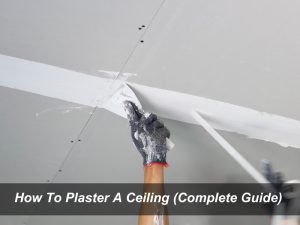How To Plaster A Ceiling (Complete Guide)
Plastering is a common home improvement task that many homeowners undertake at some point. Plastering a ceiling is a bit more challenging than plastering walls, but the process is essentially the same. If you’re planning on plastering your ceiling, here’s what you need to know.
The first step in plastering a ceiling is to remove any existing wallpaper or other material that may be on the surface. This will ensure that the new plaster adheres properly.
Next, you’ll need to apply a primer to the ceiling. This will help the new plaster bond to the surface.
Once the primer is dry, it’s time to start applying the plaster. Plaster can be applied with a trowel or a hawk and trowel. Start in one corner of the room and work your way across the ceiling, applying a thin layer of plaster.
After the plaster has been applied, allow it to dry for 24 hours. Once it’s dry, you can sand it smooth and apply a paint or wallpaper finish of your choice.
What materials will you need to plaster a ceiling
Plastering is an age-old technique that has been used to finish ceilings and walls for centuries. It can be made from a variety of materials, but the most common type is gypsum plaster.
There are two main types of plastering: wet plastering and drywall plastering. Wet plastering is the traditional method and involves applying a wet plaster mix to the surface with a trowel. Drywall plastering is a newer method that uses pre-mixed, dry plasterboard panels.
No matter which type of plastering you choose, there are certain materials you will need to get the job done.
For wet plastering, you will need:
- Plaster mix
- Water
- Trowel
- Bucket
- Sponge
For drywall plastering, you will need:
- Plasterboard panels
- Joint tape
- Joint compound
- Sandpaper
Once you have gathered all of the necessary materials, you will be ready to start plastering your ceiling!
How to prepare the surface for plastering?
There are a few things to keep in mind when preparing a surface for plastering. The first is to make sure the surface is clean and free of any debris or dirt. Any loose material should be removed and the area should be swept or vacuumed thoroughly.
The second thing to consider is the smoothness of the surface. Plaster can be applied to both rough and smooth surfaces, but a smoother surface will result in a better overall finish. If the surface is rough, it will need to be sanded down before plaster can be applied.
Once the surface is prepared, it’s time to apply the plaster. Plaster can be applied with a brush, roller, or sprayer. It’s important to evenly distribute the plaster and avoid any pooled areas. Plaster can also be applied by hand, but this is more labour-intensive and results in a less smooth finish.
Once the plaster is dry, it can be painted or otherwise decorated as desired. Plastering is a great way to improve the look of a room and make it more inviting. With a little preparation, anyone can achieve professional-looking results.
How to mix and apply the plaster
Plaster is a material that has been used for centuries to finish walls and ceilings. It can be mixed with water and applied by hand or machine. Plaster can also be purchased pre-mixed and ready to use.
When mixing plaster, it is important to follow the manufacturer’s instructions. The ratio of water to plaster will vary depending on the type of plaster being used. Once the plaster is mixed, it should be applied quickly before it begins to set.
Plaster can be applied by hand or machine. When applied by hand, a hawk and trowel can be used. The hawk is held in one hand and the trowel in the other. Plaster is scooped up onto the hawk and then transferred to the wall. The trowel is then used to smooth out the plaster.
When using a machine, Plaster can be pumped or sprayed. Plaster pumps are often used for larger jobs. Plaster is loaded into the pump and then pumped through a hose to the nozzle. The nozzle is held against the wall and the plaster is sprayed onto the surface. The plaster can also be rolled on with a paint roller.
Once the plaster is applied, it should be smoothed out with a trowel or brush. Plaster can also be textured with a variety of tools. Plaster should be allowed to dry completely before painting or applying wallpaper.
How to finish the plastering job?
When it comes to plastering, the goal is always to achieve a smooth, even surface. If you’re tackling a plastering job yourself, there are a few things you need to keep in mind to get the best results. In this article, we’ll walk you through the steps of how to finish the plastering job and provide some helpful tips along the way.
Plastering Tips:
– Always start with a clean surface. Any dirt or debris will show through the finished product, so it’s important to make sure the area is clean before getting started.
– Use tape to create sharp lines and corners. This will help you achieve cleaner results.
– Work in small sections so that the plaster doesn’t dry out before you have a chance to smooth it out.
– Use a wet sponge to smooth out the plaster as you go. This will help avoid bumps and unevenness.
– Allow the plaster to dry completely before painting or adding any other finishes. Otherwise, you run the risk of damaging the new surface.
FAQs about ceiling plastering
When it comes to ceiling plastering, there are a few things you should know. Plastering is a great way to improve the look of your home, but it can be a bit tricky if you’ve never done it before. Here are a few frequently asked questions about ceiling plastering to help you get started.
What is plastering?
Plastering is the process of covering walls or ceilings with a thin layer of material, often made from cement, lime, water, and sand. It’s typically used to smooth out imperfections in surfaces or to prepare surfaces for painting. Plastering can also be used to create decorative effects.
How do I choose the right type of plaster for my project?
There are a few things to consider when choosing plaster for your project. First, think about the type of surface you’ll be plastering. Plaster is available in different formulas for different surfaces, so make sure you get the right kind. Second, consider the amount of time and effort you’re willing to put into the project. Some types of plaster require more prep work than others. Finally, take cost into consideration. Plaster can be expensive, so you’ll want to make sure you choose a type that fits your budget.
What tools do I need for plastering?
In addition to plaster, you’ll need some other supplies before you get started. You’ll need a trowel, a bucket, sandpaper, and a damp cloth. You may also need a ladder, depending on the height of the surface you’re plastering.
How do I prepare the surface for plastering?
The first step in plastering is to prep the surface. This involves cleaning the surface to remove any dirt, dust, or debris. Once the surface is clean, you’ll need to roughen it up a bit with sandpaper. This will help the plaster adhere better.
How do I apply plaster?
Once the surface is prepped, you’re ready to start applying plaster. To do this, mix the plaster according to the manufacturer’s instructions. Then, use your trowel to apply it to the surface is smooth, even strokes. Start at the top of the surface and work your way down.
How do I remove plaster?
If you need to remove plaster for any reason, the best way to do it is with a damp cloth. Gently rub the area until the plaster comes off. You may need to use a little elbow grease, but be careful not to damage the underlying surface.
Plastering can be a great way to improve the look of your home. With a little knowledge and effort, you can achieve professional-looking results. Use these FAQs as a starting point, and don’t hesitate to ask for help from a professional if you need it
Benefits of Plastering the ceilings?
Plastering the ceilings has many benefits that can improve the look and feel of your home. Plaster can be used to create a smooth, seamless finish on your ceiling, which can help to reflect light and make your room appear more spacious. Plastering can also be used to cover up any imperfections in your ceilings, such as cracks or unevenness. Plastering the ceilings can also help to improve the acoustics in your room by absorbing sound. It is a relatively inexpensive way to update the look of your home and can be done DIY with the right tools and materials. If you are thinking about plastering your ceilings, here are some of the benefits that you could enjoy:
- A smooth, seamless finish
- The ability to reflect light
- The ability to cover up imperfections
- Improved acoustics
- A relatively inexpensive update
- The ability to DIY with the right tools and materials.
Plastering the ceilings can transform the look and feel of your home, and it is a relatively inexpensive way to update your space. If you are thinking about plastering your ceilings, be sure to consider all of the benefits that this project could offer you. With the right tools and materials, plastering is a project that you can easily do yourself, and it could make a big difference in the appearance and function of your home.

